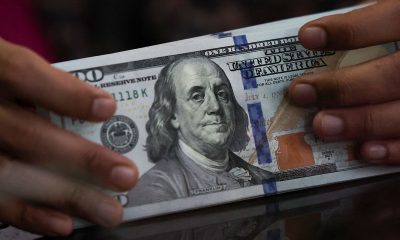Commodities
Oil prices settle higher to notch strong weekly gains as Middle East tensions jump

Investing.com– Oil prices settled higher Friday, notching strong gains for the week as geopolitical tensions bolstered bets on potential supply disruptions, though easing bets on sooner Federal Reserve rate cuts following a strong jobs report tempered gains.
At 14:30 ET (18:30 GMT), settled 0.4% higher at $86.91 a barrel, while expiring in May rose 0.6% to $86.91 a barrel, and had earlier reached levels last seen in mid-October. Both benchmarks gained about 4% on the week, their best performance since early-February.
Red-hot March nonfarm payrolls
Data released earlier Friday showed that increased by 303,000 jobs in March, much more than the expected 212,000 gain.
This red hot report has undermined hopes that the Federal Reserve will start cutting interest rates as soon as June, a cutting cycle that would likely increase economic activity and thus demand for crude in the world’s largest economy.
That said, the crude benchmarks are still on track for their best week in two months on the prospect of worsening geopolitical conditions in the Middle East, especially amid increased saber rattling between Israel and Iran.
A broader outbreak of war in the Middle East potentially heralds more supply disruptions for oil, and could further tighten markets in the coming months. Expectations of tight markets were furthered by the Organization of Petroleum Exporting Countries and allies maintaining its current pace of production cuts.
On the demand front, improving economic readings from top importer China saw traders turn more optimistic over stronger oil imports in the country this year.
Baker Hughes rig count falls
The number of oil rigs operating in the U.S. rose by rose to 508 from 506, according to data Friday from energy services firm Baker Hughes as refiners look to increase activity over the spring and summer to meet demand.
Oil prices head for bumper week on prospect of Israel-Iran war
Sentiment on oil prices was boosted chiefly by the prospect of Iran joining the Israel-Hamas war, after Tehran threatened retaliation for what it viewed as an Israeli strike on an Iranian embassy in Syria.
These threats drew a sharp rebuke from Israeli Prime Minister Benjamin Netanyahu. U.S. calls for a ceasefire in Gaza also appeared to have gone unheeded.
Worsening geopolitical conditions in the Middle East stand to potentially disrupt crude production in the oil-rich region, especially if major producer Iran becomes embroiled in a conflict.
Ongoing Ukrainian attacks on Russian refineries also added to bets on tighter crude supplies, though rising non-OPEC output including ongoing record output in the U.S. continue to muddy the demand and supply outlook.
(Peter Nurse, Ambar Warrick contributed to this article.)
Commodities
Oil prices rise; U.S. crude inventories plunge, Russia-Ukraine truce eyed
Commodities
India’s Reliance to stop buying Venezuelan oil over US tariffs, sources say
Commodities
Oil prices climb on Venezuela supply worries

 Forex3 years ago
Forex3 years agoForex Today: the dollar is gaining strength amid gloomy sentiment at the start of the Fed’s week

 Forex3 years ago
Forex3 years agoUnbiased review of Pocket Option broker

 Forex3 years ago
Forex3 years agoDollar to pound sterling exchange rate today: Pound plummeted to its lowest since 1985

 Forex3 years ago
Forex3 years agoHow is the Australian dollar doing today?

 Cryptocurrency3 years ago
Cryptocurrency3 years agoWhat happened in the crypto market – current events today

 World3 years ago
World3 years agoWhy are modern video games an art form?

 Commodities3 years ago
Commodities3 years agoCopper continues to fall in price on expectations of lower demand in China

 Economy3 years ago
Economy3 years agoCrude oil tankers double in price due to EU anti-Russian sanctions

























